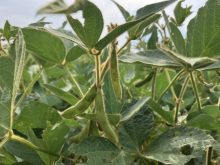Compared to last week, western Canadian yearling markets traded $2-$4 lower; calves over 700 lbs. appeared to hold value; calves weighing less than 700 lbs. were down $3 to as much as $5.
The yearling run is basically finished. Ontario buying interest was supportive in the eastern Prairie regions due to the bumper corn crop; however, markets were rather sluggish in Alberta and western Saskatchewan. Buyers were more aggressive on fancier calves; flesh conditions will increase later in fall and major operations dominated 700-plus-lb. calf packages. The number of calves straight off their mothers surged this past week. Buyers for larger operations also focused on packages with health records, although these groups didn’t show much of a premium. Weather has been optimal besides wind annoyance in southern Alberta. There were also significant volumes of calves under 500 lbs. Cow-calf operators are selling calves sooner than normal with forage costs at historical highs. Grazing conditions improved late in the season, but this hasn’t altered the marketing time frame for many operators.
Read Also

Huge crops in South America says analyst
Although there’s a debate over the size of the South American soybean crop, there’s little doubt that it will be an enormous one, said consultant Michael Cordonnier of Soybean and Corn Advisor in Hinsdale, Ill.
In Manitoba, Charolais-based steers averaging 835 lbs. were valued at $202 and a small group of heifers weighing a shade under 900 lbs. were quoted at $169. In central Saskatchewan, medium- to larger-frame Angus-blended steers weighing 815 lbs. were quoted at $194 and similar-quality 830-lb. heifers were reported at $171. In central Alberta, a small group of mixed steers averaging 900 lbs. were reported at $187. In a video sale near Lethbridge, a large string of steers averaging 940 lbs. were quoted at $194 f.o.b. the ranch.
In southern Alberta, Simmental-based steers averaging 710 lbs. were valued at $206 landed in the feedlot; larger-frame heifers with partial Limo genetics averaging 740 lbs. were valued at $173 in the same region. At a video auction near Lethbridge, a larger group of heifers averaging 700 lbs. sold for $175 f.o.b. the ranch.
South of Edmonton, unweaned black steers with full health records averaging 615 lbs. dropped the gavel at $199 and unweaned tan mixed steers weighing just shy of 500 lbs. were quoted at $214. In southern Manitoba, featherlight black steers weighing 380 lbs. reached up to $270 and their older brothers weighing 477 lbs. were quoted at $230.
Grassers will be hot next spring; this is sure. The U.S. Department of Agriculture’s WASDE report estimated a year-over-year decline of 400 million lbs. in fourth-quarter beef production for 2022. At the same time, the energy crisis in China and Europe will continue to underpin corn values. Ethanol demand has potential to surge later in the crop year, thereby driving coarse grain values higher.
— Jerry Klassen is president and founder of Resilient Capital, specializing in proprietary commodity futures trading and market analysis. Jerry consults with feedlots on risk management and writes a weekly cattle market commentary. He can be reached at 204-504-8339 or via his website at ResilCapital.com.
















